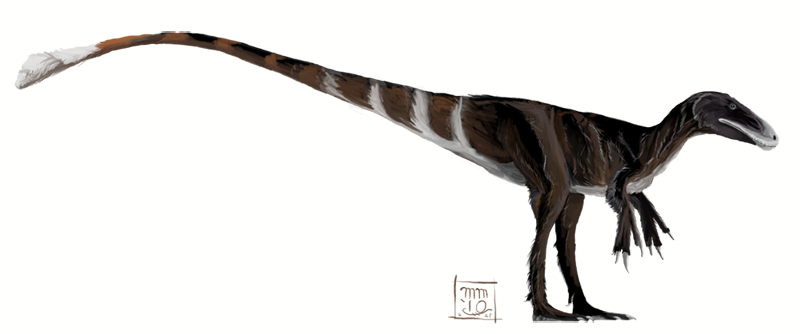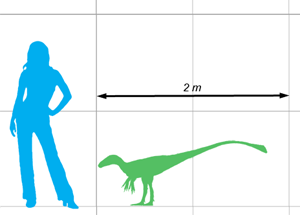home > natural history
Dilong paradoxus
"surprising emperor dragon"

Dilong paradoxus is famous mostly for raising the possibility that the most popular of all dinosaurs, whose iconic image is ingrained in the imaginations of everyone in the western world (i.e. Tyrannosaurus rex) may have had feathers. The initial description of Dilong, based on two specimens from the Yixian Formation, found it to be on the tyrannosaur line (Clade Tyrannosauridae/Superfamily Deinodontoidea). However, the relationships of primitive coelurosaurs are infamously obscure, and it didn't take long for more analyses to find it somewhat closer to birds, or to coelurids, or both. Though coelurids themselves might be deinodontoids. Either way, all these animals are extremely similar, so even if Dilong is a bit closer to birds than to deinodonts, it's likely primitive deinodonts still had some kind of feathery covering. Unless Dilong and the (other) coelurids represent the first appearance of feathers among theropods, which would be a bit surprising.
For all the feathers Dilong has ruffled, it doesn't preserve many of its own. The more complete holotype specimen is from the Lujiatun beds of volcanic sediment, preserved in three dimensions with no feather traces. The referred specimen is from contemporary lake sediments, but still only preserve a few patches of feathers (on the lower jaw and tail), the rest having degraded before fossilization or simply not been preserved. The skeletal restoration provided with the paper somewhat misleadingly restored feathers covering the whole animal, but their arrangement and length is hypothetical. Most famously, the skeletal included a plume of long feathers at the tail tip, which I've restored here, though there is no actual fossil evidence for this. Still, the puff-tail has become a "traditional" feature for Dilong in art and adds a flair to the partially striped tail, a pattern based on the related Sinosauropteryx. The countershading and patches of chestnut brown coloration are also based on that smaller coelurosaur.
Image Details:
Media: Digital painting, Adobe Photoshop CS3
using WACOM Graphire 3
License:
ALL RIGHTS RESERVED
DESCRIPTION
Length: 1.6m (5ft 3in)
Weight: 4kg (8.8lbs)
Location: Yixian Formation, Liaoning, China
Time: Aptian age, Lower Cretaceous (125Ma)
CLASSIFICATION
Kingdom: Animalia
Phylum: Chordata
Class: Stem-Aves
Order: Coeluria
Superfamily: Deinodontoidea
Genus: Dilong
Species: D. paradoxus
SYSTEMATICS
Sauropsida
Diapsida
Archosauria
Ornithosuchia
Dinosauria
Theropoda
Coelurosauria
Tyrannosauroidea
